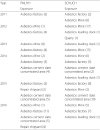1. Choi JK, Paek D-M, Paik NW. The production, the use, the number of workers and exposure level of asbestos in Korea. Korean Ind Hyg Assoc J. 1998; 8:242–253.
2. Ki Y-H, Kim J-M, Roh Y-M, Chung L, Kim Y-S, Sim S-H. A survey for some asbestos-containing products in Korea. Korean J Environ Health Sci. 2008; 34:108–115. DOI:
10.5668/JEHS.2008.34.1.108.
3. Doll R. Mortality from lung cancer in asbestos workers 1955. Br J Ind Med. 1993; 50:485. PMID:
8329311.
4. Wagner J, Sleggs C, Marchand P. Diffuse pleural mesothelioma and asbestos exposure in the North Western Cape Province. Br J Ind Med. 1960; 17:260–271. PMID:
13782506.
5. Park M, Choi J, Choi H, Jang T, Moon I, Kim J, Jang T, Lee D, Jung M, Kang S. A case of diffuse malignant pleural mesothelioma with occupational asbestos exposure. Korean J Med. 1995; 48:526–530.
6. Kang DM, Kim JW, Son BC, Kim JI, Woo JC, Lee JT. A case of malignant pleural mesothelioma combined with asbestosis in a boilermaker and plumber. Korean J Occup Environ Med. 1998; 10:610–617.
7. Ye BJ, Kim JI, Lee HJ, Kim KN, Lee KN, Jung KY, Kim JY, Yun SH. The prevalence of asbestos exposure-induced pleural thickening on chest radiograph in repairing shipyard workers. Korean J Occup Environ Med. 2008; 20:9–14.
8. Park S-H, Kang D-M, Koo B-H, Kim Y-K, Kim J-E. Risk assessment of gastric cancer associated with asbestosis: a case report. Ann Occup Environ Med. 2015; 27:1. DOI:
10.1186/s40557-014-0044-x. PMID:
25729584.
9. Roh S, Park S, Tae G, Song J. A case of laryngeal cancer induced by exposure to asbestos in a construction site supervisor. Ann Occup Environ Med. 2016; 28:34. DOI:
10.1186/s40557-016-0114-3. PMID:
27504188.
10. Kang D-M. Health Effects of environmental asbestos exposure. Korean J Environ Health Sci. 2009; 35:71–77. DOI:
10.5668/JEHS.2009.35.2.071.
12. Kang D-M, Kim Y-K, Kim J-E. Asbestos and environmental diseases. J Korean Med Assoc. 2012;55(3):214-222.
13. Bae H, Kang D, Kim Y, Kim J, Kim Y, Kim KI, Kim K. Respiratory symptoms, pulmonary function tests, and asbestos related chest radiograph abnormalities of former asbestos textile factory workers. Korean J Occup Environ Med. 2010; 22:331–344.
14. Im S, Youn K-W, Shin D, Lee M-J, Choi S-J. Review of carcinogenicity of asbestos and proposal of approval standards of an occupational cancer caused by asbestos in Korea. Ann Occup Environ Med. 2015; 27:1. DOI:
10.1186/s40557-015-0080-1. PMID:
25729584.
15. Kang D, Myung M-S, Kim Y-K, Kim J-E. Systematic review of the effects of asbestos exposure on the risk of cancer between children and adults. Ann Occup Environ Med. 2013; 25:1. DOI:
10.1186/2052-4374-25-10. PMID:
24472298.







 PDF
PDF Citation
Citation Print
Print



 XML Download
XML Download